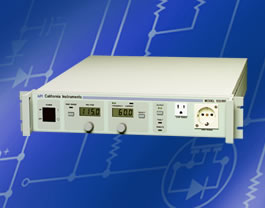 California Instruments' RP series are ideal sources for general purpose AC power applications that require variable voltage and frequency at power levels up to 2000 VA.
California Instruments' RP series are ideal sources for general purpose AC power applications that require variable voltage and frequency at power levels up to 2000 VA.
When selecting an AC source for a test application, such as the California Instruments RP Series or CTS Series, you need to know more than just how much current your unit under test (UUT) will draw under normal operating conditions. You also need to consider how much current the unit will draw when starting up, when changing operating modes, or when there's a fault with the unit under test. Be sure to include inrush current and transient currents that may occur when first applying voltage or when the input voltage changes during the course of a test.
What's the worst case?
Rectifier-type power supplies and motors are notorious for drawing high inrush currents. These devices have inrush currents anywhere from two to ten times the nominal operating current, and they will draw this current anywhere from a few cycles to several seconds.
AC motors, for example, can draw up to seven times the normal operating current when first started. How long the motor will draw this current depends on the mechanical load and the motor design.
AC power sources are designed to protect themselves from excessive load current, such as high inrush current, by either reducing the output voltage (foldback current limiting) or shutting down the output (current-limiting shutdown). In some cases, the user can select which current-limiting mode that the power supply uses. If, however, you must measure the inrush current or your test calls for supplying the full inrush current as part of the test, you will need an AC source that can supply the full peak inrush or transient currents, so that the source never reaches the foldback state.
When the test specification does not require that the AC source supply the peak inrush current, or when it's just not practical to use a high-current AC source, it may be possible to use a source that can supply the normal operating current, but use the foldback current-limiting technique during startup. This will result in longer start-up times for a particular test, but enables you to use lower-current, and therefore lower-cost, AC sources.
One caution here is that a source that is not capable of supplying the proper level of voltage and current may remain in the current-foldback state too long, and this may cause the device under test to not start correctly or shut off altogether.
If you have questions about how much current you really need, please e-mail sales.ppd@ametek.com or call 800-733-5427. We can help you select the source that's right for your test application.
